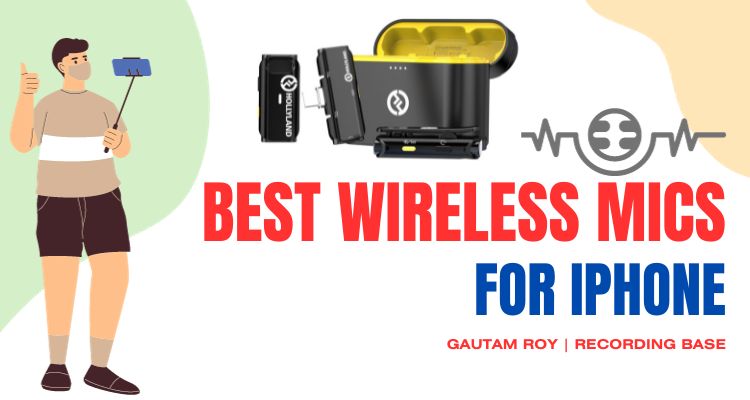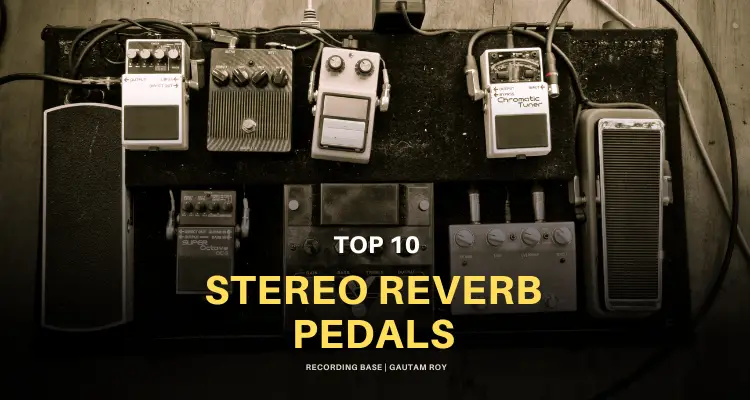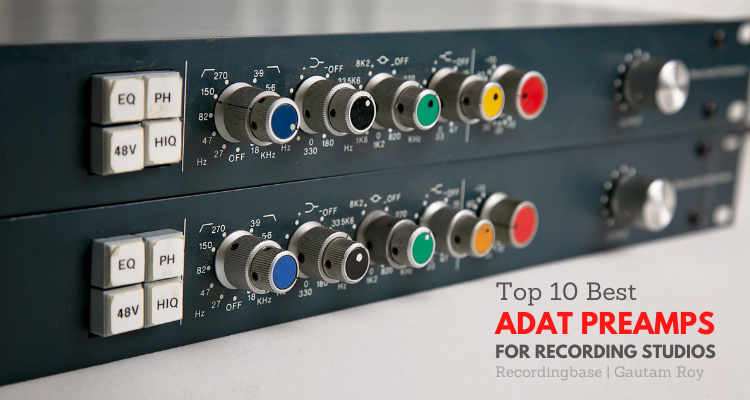Do you want to record drums in your home studio? If yes, then you have landed at the right place.
This is the ultimate guide to drumming mics in which you will get all the information needed to record drums in home studios, such as drum mic placement techniques, types of drum mics, the best drum mics for home studios, live concerts, drum mic kits, etc.
This drum mic tutorial will guide you through recording drums in the studios and help you set up drum mics for live concerts.
So, let’s get started…
You might also like,
- Neat Bumblebee II Review | Best USB Podcast Mic in 2023?
- How to Connect XLR Mic To Computer [3 Methods]
First off,
Table of Contents
- 1 How Drum Mics are Different from Other Mics?
- 2 Individual Drum Mics VS Drum Mic Kits
- 3 Types of Drum Mics
- 4 Top 10 Drum Mics For Home Studios and Live Performance
- 5 1. Sennheiser E604 Dynamic
- 6 2. Shure BETA 52A Dynamic
- 7 3. AKG Pro Audio D12VR
- 8 4. Audio-Technica AE2500
- 9 5. Audix D6 Dynamic Drum Mic
- 10 6. Shure SM 81 (For Cymbals)
- 11 7. Shure SM57 (For Snares)
- 12 8. AKG D112 MkII
- 13 9. Shure SM7B
- 14 10. Sennheiser MD 421
- 15 5 Best Drum Mic Kits
- 16 1. Audix DP7 Plus
- 17 2. Shure PGADRUMKIT5
- 18 3. Shure PGADRUMKIT7
- 19 4. Sennheiser E600 Drum Mic Kit
- 20 5. Avantone Pro CDMK-8 Drum Mic Kit
- 21 5 Steps to Drum Mics Placement Guide
- 22 General FAQ About Drum Mics
- 23 Conclusion: Drum Mics Beginners Guide
- 24
How Drum Mics are Different from Other Mics?
If you have an existing recording studio, then I’m sure you already have vocal and instrument mics.
So, when you get a project that needs a drum session, you want to record drums with those mics that you already have in your studio.
Disclosure: This post may contain affiliate links, which means we may receive a commission if you click a link and purchase something that we recommended. Read more about Affiliate disclosure here.
Right?
Well, I’m not talking about your vocal condenser mic, but you may want to use your extra mics for drums that you bought to record soft instruments like acoustic guitars and ukuleles.
If you are thinking of it, I would tell you it’s not the right decision because it may severely damage your mics, mainly if you use your melody instrument mics over the kicks.
The sound pressure level of the kick drum is much more than a melody instrument. Therefore, when a mic that is designated to record low proper pressure levels is used to record high-pressure instruments, such as drums, it may damage the mic’s diaphragm.
Here comes the importance of drum mics.
Drum mics are specially designed to record high sound pressure levels so they do not damage record drums.
As you can see in the below image, the diaphragm of a vocal or soft instrument mic is made of a susceptible and thin material layer.
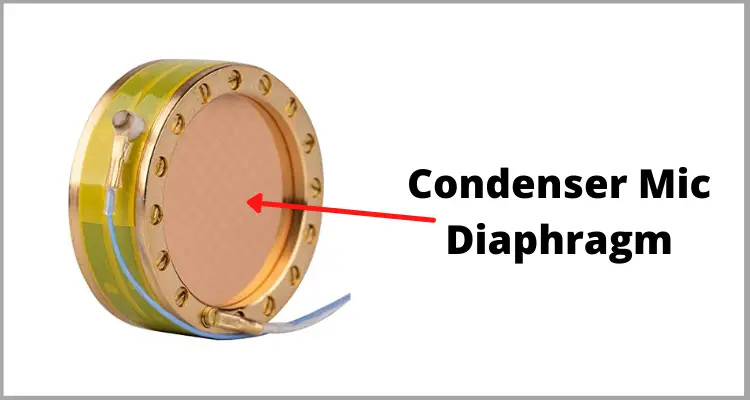
This thin layer captures minor sound vibrations but is not capable of capturing high sound pressure. Hence, when high pressure is applied in front of this layer, it will be damaged.
On the other side, the drum mic diaphragm is made of thick layers of material. So they easily capture the high sound pressure without getting damaged.
That’s the main difference between vocal/melody mics and drum mics.
Other differences between drum mics and vocal mics that you should know about are,
- Drum mics are mainly dynamic mics, whereas vocal/instrument mics are either condenser or dynamic.
- Vocal/instrument mics respond to a wide frequency range, whereas drum mics react to a limited frequency range.
- Drum mics are not as sensitive as vocal/melody mics.
- Kick drum mics easily capture SPL of around 130dB-160 dB, which is the ideal sound pressure level of a kick drum, but vocal/melody microphones can be damaged above 130 dB. However, according to Neumann, modern condenser mics withstand above 130 dB.
These are some other differences between a vocal/melody mic and a drum mic.
Individual Drum Mics VS Drum Mic Kits
So, now you’ve changed your decision to use your existing mics with the upcoming drum session. Now you don’t want to damage them and are ready to purchase drum mics.
But, here, another confusion arises.
Which one Should you buy?
Individual drum mics or drum mic kits?
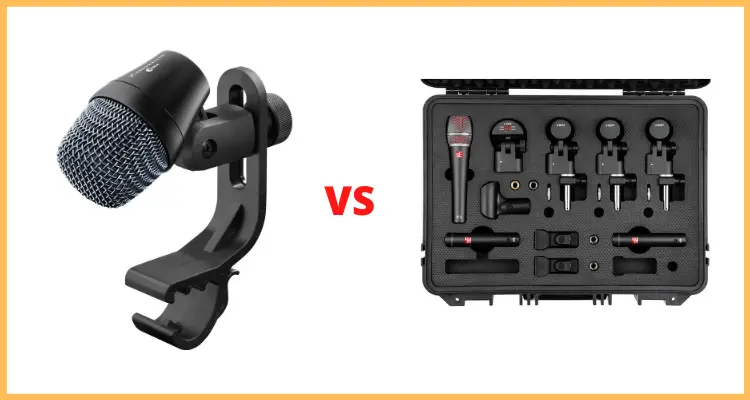
As individual mics and mic kits both are available in the market, it creates confusion among beginners about which one they should go with.
In this chapter, I will compare individual drum mics VS drum mic kits that will help you choose one that would be suitable for your need.
First,
Pros and Cons of Individual Drum Mics
Pros
- You have the independence to choose mics from different brands and models
- You can make your own drum mic kit with different types of mics
- It all depends on you how many mics you want to use for the drums
Cons
- You should have a bit of technical knowledge to choose the right mics for kicks, cymbals toms, etc
- It’s not easy to carry 5-6 individual mics with different carry bags
Pros and cons of drum mic kits
Pros
- Drum mic kits are easy to carry and use
- You don’t have to research and buy mics individually for kicks, cymbals, snare, and toms
- You get all mics in the same box, that’s great for gigs
Cons
- You have to depend on one brand
- You can’t assemble your own drum mic kits (Exceptions are there)
- Drum mic kits are more costly than individual drum mics
Above I have given some pros and cons of both the options. I think it’s cleared your confusion about choosing drum mics.
The essence of the above discussion is that if you are buying it for a live concert or you don’t want to research assembling your own kit, you should go with these readymade drum miking kits.
But, if you will use it in your recording studio or you can research on your own, you must consider an individual way of selecting drum mics.
This way, you can record drums as a pro recording engineer does. In addition, you have the independence to select mics from different brands and models.
Now let’s talk about different types of drum mics such as overhead mics, kick drum mics, snare, tom, hi-hat, and cymbal mics.
Types of Drum Mics
Whether you want to buy drum mic kits or go with an individual approach, this chapter is equally helpful for both types of people.
In this chapter, you will learn about different types of drum mics.
As you know, drums are made of different parts such as kick, snare, hi-hat, toms, and cymbals.
These all parts sound very different from each other, so the acoustic characteristics (frequency curve) of all are different from each other.
See the below frequency chart.
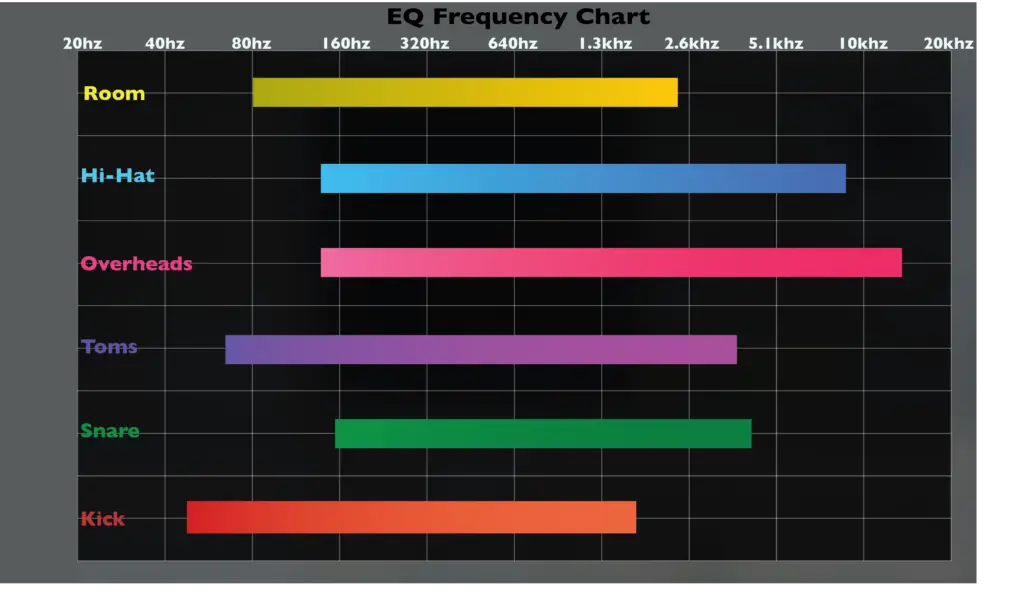
If you want to learn more about the frequency graph of drums, then you should read this guide by Jam Addict.
That’s why you need different mics for each of them.
Below you will learn about different mics used for recording drums (kick, snare, hi-hat, toms, and cymbals).
First off,
Overhead/Room Mics
The overhead mic is placed above the instrument (in our case, drums) to record the instrument’s overall sound.
Apart from the other instruments with only one sound source, drums have several sound sources such as kick, snare, hi-hat, toms, and cymbals. So, we need an overhead mic to record all of them in one track.
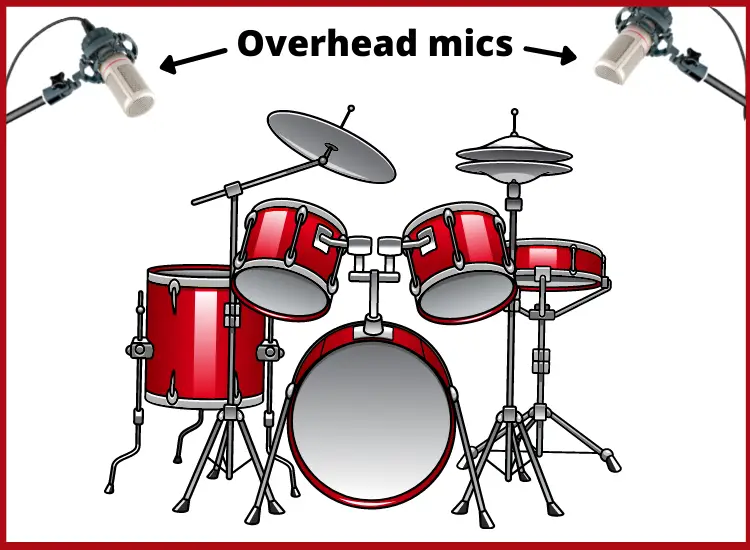
Overhead mics are used to create ambiance so that the record would not become dry. Additionally, when the overhead mic is used with individual mics, it captures a natural-sounding drumming session.
In studios, condenser mics are used for overhead drum miking; however, you can also use any good dynamic and frequency range dynamic mic.
Shure has written a great article on overhead mics that you can read here.
Kick Drum Mics
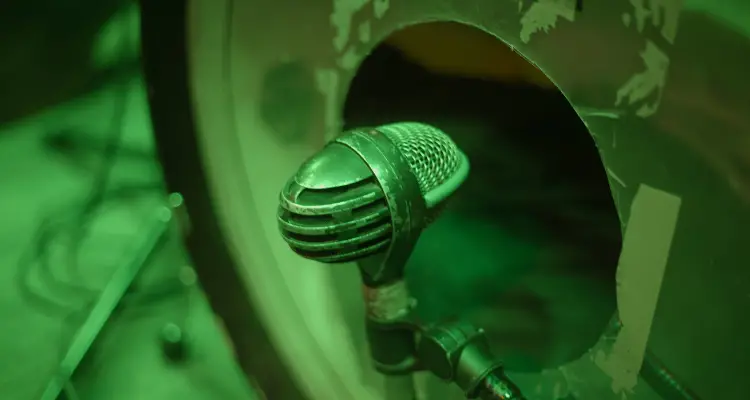
A kick drum mic is used to record the kick drum.
These mics are responsible for low frequencies somewhere between 30 Hz to 200 kHz.
Kick drum mics are dynamic cardioid microphones.
As we know, the Kick drum produces the most SPL level among all other parts of the drums. That’s because the average sound pressure (SPL) of a kick drum is between 120 dB to 150 dB, which is really high.
So, kick drum mics are specially designed to stand in these SPL levels. These mics can handle extremely high SPLs (over 144 decibels) without any distortion.
Snare Drum Mics
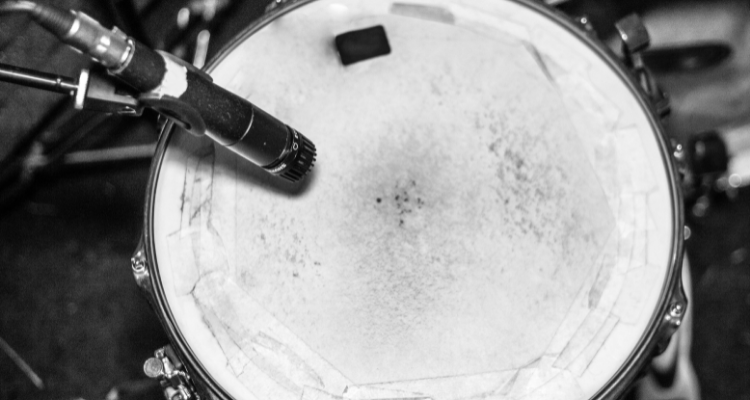
Snare drum mics are used to record snares, one of the essential parts of a drum machine.
There are so many different kinds of snare drum sounds, from big and fat to thin and ringing and everything in between.
Several different types of mics are used to capture these sound patterns. It is said that every engineer uses his own choice of mics.
Well, I don’t want to confuse you here, so you can use a higher frequency response cardioid dynamic microphone to record your snares.
Microphones, such as Shure SM57, are perfect for snares. This is because it has a high-frequency response, as shown in the figure below.
If you want to learn more about the frequency graph of drums, then you should read this guide by Jam Addict.
Hi-Hat Mics
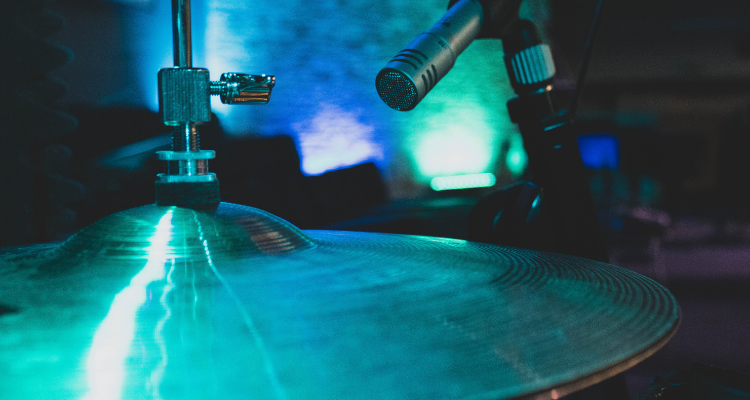
For Hi-Hats, basically, small-diaphragm condenser mics are used. However, you can go with their dynamic alternatives, but the result a small-diaphragm condenser gives a dynamic mic doesn’t.
Maybe you are thinking as snares and hi-hats are close to each other, why not you should use one mic for both?
Well, the sharpness of snares would eat up the clarity of the hi-hats, and you will get the worst quality hi-hat sound if you record both hi-hat and snare through a single mic.
Another reason for recording hi-hats separately is its high-frequency sound.
Hi-hats are part of high-end percussions, so you should record them separately. In addition, Sperate tracks of high-end percussions help us in better mixing.
That’s why a separate hi-hat mic is used. However, it would help if you used small-diaphragm mics, mainly, condenser mics to record hi-hats.
I’ll give you some great recommendations for hi-hat mics in the upcoming chapters of this guide.
Tom Mics
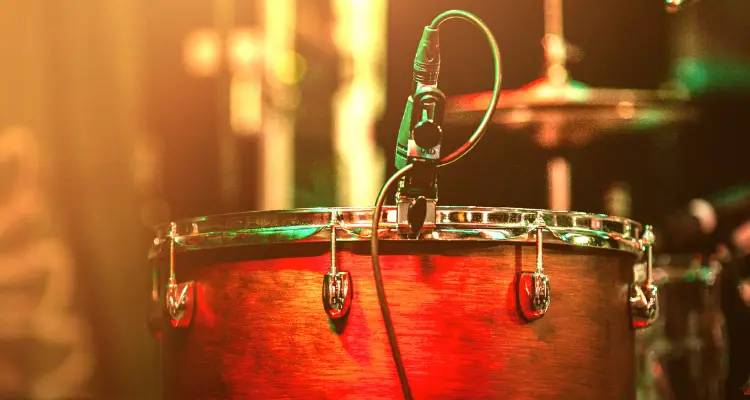
The frequency range of toms is similar to snares; however, the attack and release are not so sharp. But, for toms, you can use the same mics that are used for snares. For example, a Shure SM 57 is an excellent fit for toms as well.
other alternatives of SM 57 are Beyerdynamic M 201 TG and Neumann KM 184.
Cymbal Mics
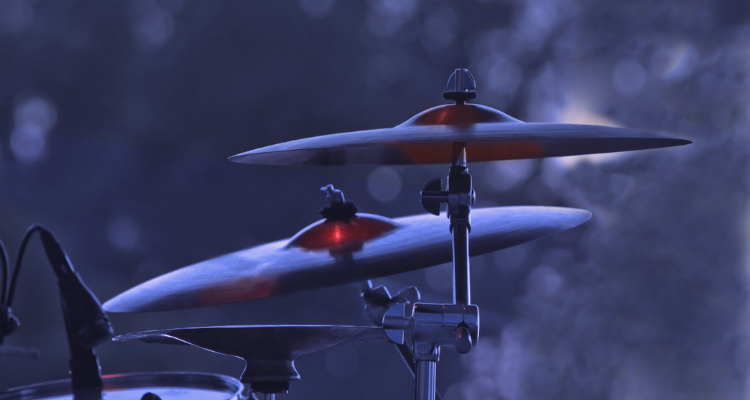
Cymbal is a slow attack and slow-release instrument part of the drum machine. Hence it would be best to have a mic that captures the lowest possible dB after the hit.
That’s why I recommend a condenser mic with a small diaphragm. It captures the high as well as low dynamics of the sound.
You can use the same model of small-diaphragm condenser mics that you are using for hi-hats.
If you don’t want to use separate cymbal mics, then an overhead mic is sufficient to record the ambiance of cymbals with all other drum parts.
But, if you want a genuinely professional-sounding drum session, then you should use separate cymbal mics along with overhead condenser mics.
Now you have the basic knowledge of all types of mics used in drums recording.
Let’s come to the next chapter.
Top 10 Drum Mics For Home Studios and Live Performance
In this chapter, you will read about the ten best mics for home studios and live performances. In addition, this chapter will help you to choose mics that fits your need and budget.
First off,
1. Sennheiser E604 Dynamic
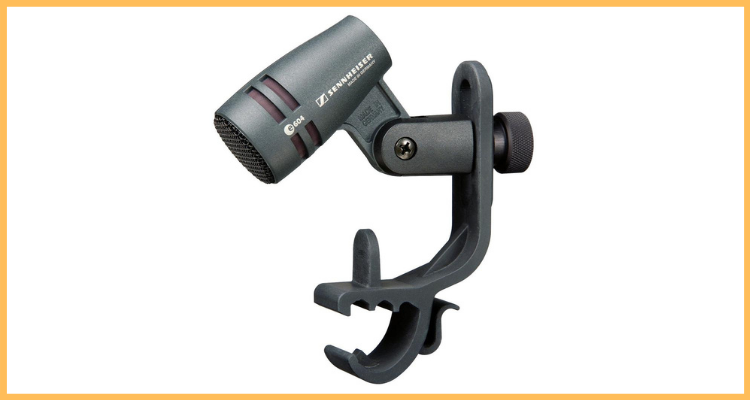
- Microphone Type: dynamic
- Polar Pattern: cardioid
- Best use: Toms and Snare
- Frequency Response: 40Hz-18kHz
- Connector: XLR cable type
- Accessories included: drum clip mount
Sennheiser E604 is a dynamic cardioid instrument microphone known as one of the best microphones in the world to record the rims of tom-toms and snares.
It comes with a clip-on holder that is used to mount it over the snares and toms.
With this clip hanger, it’s effortless to mount and position Sennheiser E604 over the toms and snares.
It has the upper mids and high-frequency response that is great to record toms and snare.
Features of Sennheiser E604
- It has the rugged reinforced glass-fiber body
- The low sensitivity of this mic is helpful to impact and handling noise
- Very high sound pressure handling capability hence best for drums
- Produce low distortion in high SPL
- Hum compensating coil
- Easy to position due to the compact design and clip hanger provided with the package
- Integral stand mount
- Frequency response range of 40Hz-18kHz
Pros
- It can be easily positioned and mounted
- Best for Toms and snares
- Low distortion
- Hum compensating coil
- Low sensitivity
- Frequency range: 40 – 18 kHz
Cons
- It’s difficult to buy this mic individually
My verdict
I have this mic in my studio and regularly use it in my sessions. So if you buy this, it will not disappoint you. The wide range frequency response with some boost at 5kHz-6kHz is a great mic to record toms and snares and other mid-high frequency instruments.
2. Shure BETA 52A Dynamic
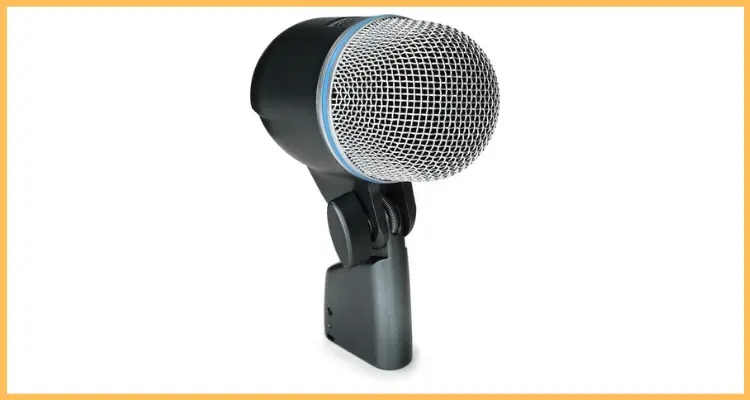
- Microphone Type: dynamic
- Polar Pattern: super-cardioid
- Best use: Kick drum
- Frequency Response: 20Hz-10kHz (presence boost at 4kHz)
- Connector: XLR cable type
- Accessories included: RK321 Replacement Grille and A26X Desk Stand Extension Tube
Shure is a well-known brand among microphone manufacturers. Shure Beta 52A is available as part of the DMK57-52 Drum Mic Kit. However, you can also buy it individually.
Shure BETA 52A is primarily built for kick drums and low-end instruments. The frequency response of 20Hz-10kHz with a presence boost at 4kHz makes it an ideal mic for kick drums and bass guitars.
The super-cardioid polar pattern limits the interference that comes from other nearby sound sources and reduces feedback.
Features of Shure BETA 52A
- The frequency response is designed especially for kick drums and bass instruments such as acoustic bass and bass amps.
- It comes with a built-in dynamic locking stand adapter and an integral XLR connector that makes it super easy to clamp with the kick drum.
- Low distortion at extremely high sound pressure levels
- Supercardioid pattern is excellent for rejection of unwanted noise
- The hardened steel mesh grille allows it to resist wear and abuse
- It comes with an advanced pneumatic shock mount system which is essential to reduce mechanical noise
- Neodymium magnet used for high signal–to–noise ratio
- Low sensitivity
Pros
- Ideal for kick drums and other bass instruments
- The 4kHz boost makes it great to record bass guitar and bass amps
- Supercardioid pattern to reduce unwanted noise
- Low distortion at high SPL levels
- Pneumatic shock-mount system
Cons
- Price is higher than other alternatives
- Not for instruments other than bass
- Absorbs some sound from the backside
- Prone to damage by humidity.
My verdict
In my opinion, Shure BETA 52A is an excellent mic for kick drums and other bass instruments.
If you have some more budget, then you should go with this mic. Otherwise, there are other alternatives available in the market.
I saw it in my friend’s studio who is using it and very satisfied with its performance. So, I recommend this mic for kick drums.
3. AKG Pro Audio D12VR
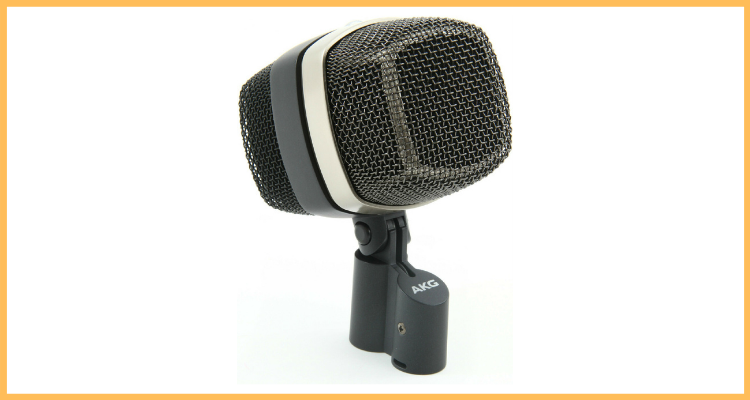
- Microphone Type: dynamic
- Polar Pattern: cardioid ( Large Diaphragm)
- Best use: Kick drum and percussions
- Frequency Response: 17Hz-17kHz
- Connector: XLR cable type
- Accessories included: Microphone Bag
AKG Pro Audio D12VR is another great mic for kick drums as well as other instruments. It has a wide frequency range of 17Hz-17kHz with a boost at 50Hz for kick drums and 6kHz for mid-range instruments such as toms and snares.
It has three switch positions to boost and cut the frequencies at 50kHz, 800Hz, and 6kHz. When you position the switch right, it will increase the frequency at 6kHz; when switched to the middle, cut the frequency at 800Hz, and when left, it will boost at 50Hz.
You can use the switch positions as per the instruments you want to record.
Features of AKG Pro Audio D12VR
- For better reproduction of the instrument sound, an ultra-thin diaphragm is used in this mic.
- An optimized bass chamber is provided to enhance the frequency performance.
- Active filter presets(Switch) to match the drum character.
- Equipped with an original C414 transformer that delivers a warm sound at high signal levels.
- Cardioid polar pattern reduces the nearby instrument interference.
Pros
- Switchable boost and cut frequency filter
- Best for kick drums
- Thin diaphragm to capture better bass frequencies
- Delivers warm vintage sound
Cons
- Not the alternative of legendary D12
- High price
My verdict
If you can pay a high price, then definitely this is a multipurpose drum mic. The active filters given in this mic allow you to use various drum applications, from kick drums to hi-hats.
But, it does not perform well with other than a kick drum, so if you want it solely for kick drums, then it’s a great alternative to Shure BETA 52A.
4. Audio-Technica AE2500
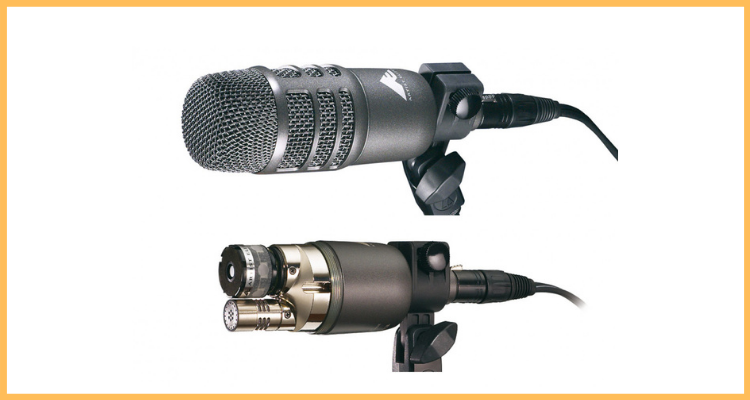
- Microphone Type: dynamic and condenser combined
- Polar Pattern: cardioid ( Large Diaphragm)
- Best use: Kick drum and percussions
- Frequency Response: 20-17,000 Hz (condenser) and 30-10,000 Hz (dynamic)
- Connector: Integral 5-pin XLRM-type to two standard 3-pin XLRM connectors
- Accessories included: AT8471 isolation clamp for 5/8″-27 threaded stands; 5/8″-27 to 3/8″-16 threaded adapter; soft protective pouch
Audio-Technica AE2500 is a new technology drum mic that consists of dual miking technology, i.e., cardioid condenser and dynamic capsules combined in one housing.
The dynamic capsule delivers the aggressive attack of the beater, while the condenser capsule captures the round tonalities of the shell.
The condenser capsule is optimized for more tension that giving it long-term consistency and stability.
The combination of both the dynamic and condenser capsules captures the original sound of the kick drum without losing its quality.
Features of Audio-Technica AE2500
- Two capsules, i.e., condenser and dynamic, are enclosed in a single housing.
- The revolutionary dual-capsule design provides a far better recording quality than other mics.
- The dynamic capsule delivers the player’s attack, while the condenser capsule captures the instrument’s tonality.
- Both the capsules are positioned in a perfect phase relationship that is impossible to achieve with two separate microphones.
- An integral 80 Hz HPF (high-frequency filter) switch is given with a 10 dB pad for the condenser capsule.
- Comes with an isolation clamp for shock protection and secure mounting.
Pros
- Ideal for kick drums and percussions
- Integral 80 Hz HPF
- dynamic and condenser capsules combined
- Low distortion at high SPL levels
Cons
- Price is higher than other alternatives
- Absorbs some sound from the backside
- Prone to damage by humidity.
My verdict
Audio-Technica AE2500 features a condenser and a dynamic capsule in one mic. The price is high. If you ask me about the performance, it delivers far better sound quality than all the mics discussed earlier.
So, if you have the budget, then you can go with this mic.
Honestly, I don’t have this drum mic, but one of my friends recently bought this, and I reviewed this at his studio.
It’s one of the best mics, not just for kick drums but all other parts of the drums as well.
5. Audix D6 Dynamic Drum Mic
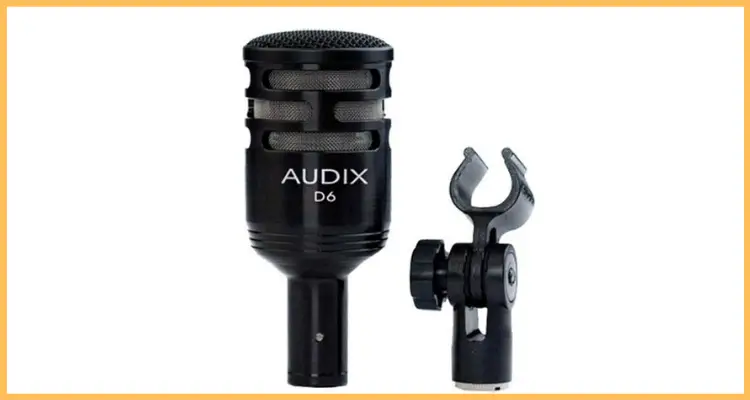
- Microphone Type: dynamic
- Polar Pattern: cardioid
- Best use: kick drums, large toms, and bass cabinets
- Frequency Response: 30 Hz – 15 kHz
- Connector: 3-pin XLRm connector
- Accessories included: Microphone Clip, Carrying Pouch
The D6 dynamic drum microphone is used in low-frequency applications. The cardioid pickup pattern is great for isolation and feedback control.
In addition, the D6 drum microphone comes with a VLM™ diaphragm which provides natural, accurate sound reproduction of the instrument used.
It’s lightweight, compact, and easy to position for drums.
D6 cardioid mic is an excellent choice for kick drums, large toms, and bass cabinets. The low impedance and balanced output allow you to give an interference-free performance.
Features of Audix D6 dynamic drum mic
- It’s designed for low-frequency sound reproduction
- Made from solid aluminum
- Cardioid pickup pattern for better isolation from nearby instruments
- Dynamic transducer
- Frequency response of 30Hz – 15kHz
- 144dB max SPL
Pros
- Solid aluminum body
- Frequency response of 30Hz – 15kHz
- Cardioid pickup pattern
- VLM™ diaphragm
Cons
- Needs extra compressor and limiter plugins to control the isolation and feedback control
My verdict
It’s a better deal under a small budget which is perfect for home studio owners.
However, it needs some extra precautions to maintain the isolation on stages, but it’s an ideal drum mic for acoustically treated studios. So if you are going to buy for your studio, then you can go with this mic.
6. Shure SM 81 (For Cymbals)
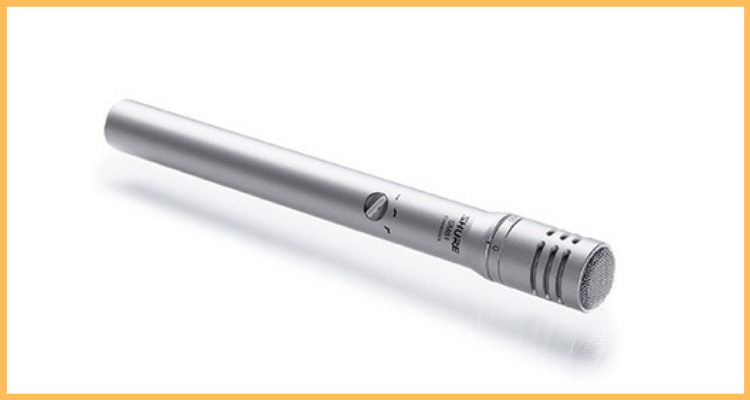
- Microphone Type: condenser
- Polar Pattern: cardioid
- Best use: Toms, Cymbals, and Hi-hats
- Frequency Response: 20 Hz to 20 kHz
- Connector: 3-pin XLR connector
- Accessories included: swivel adapter, attenuator-switch lock, foam windscreen, carrying case
The SM81 is the best choice to mic up acoustic instruments such as acoustic guitar, piano, cymbals, hi-hats, and toms. You can use it on stage as well as in recording studios.
It’s a condenser microphone, so you will get a nearly flat response curve to reproduce the instrument’s sound accurately.
You will also get a 0dB/10bB lockable attenuator switch that gives you the flexibility of miking a loud sound source.
The cardioid polar pattern allows you to isolate the main instrument while minimizing feedback noise. However, it’s a condenser mic. You can’t deserve better isolation than a dynamic mic.
Features of Shure SM 81
- You will get a 20 Hz to 20 kHz flat frequency response
- The flat response curve gives you to record the accurate reproduction of sound sources
- High output clipping levels with low noise
- Low distortion on loud instruments
- Cardioid polar pattern
- Flat, 6 or 18 dB/octave rolloff
- 0 dB/10 dB lockable attenuator switch
- Phantom power
- Durable, rugged steel construction
Pros
- Flat frequency response
- pure and clear sound reproduction
- Rich low end
- Durable construction
- Low distortion rate
Cons
- A bit expensive
My Verdict
It’s a perfect condenser mic for toms, hi-hats, and especially for cymbals. In addition, it provides a flat frequency curve so you can record different types of acoustic instruments with this mic.
This mic is not only used for drums but other instruments in your studio. So you can buy it for multiple uses. But I don’t recommend a condenser mic over the stage. It’s best for studio use.
7. Shure SM57 (For Snares)
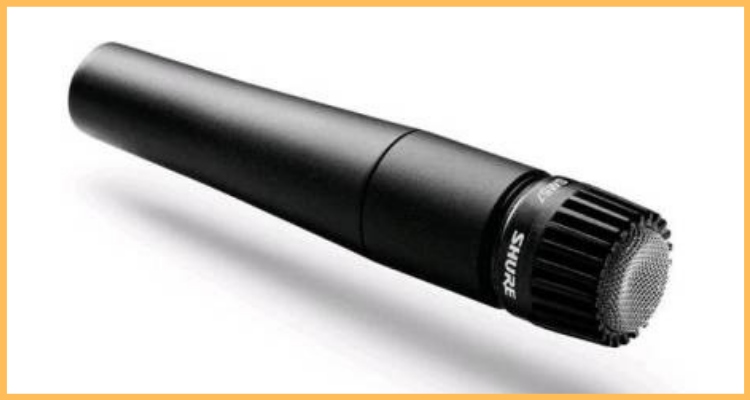
- Microphone Type: dynamic
- Polar Pattern: cardioid
- Best use: Snares, Toms, Cymbals, and Hi-hats
- Frequency Response: 40 Hz to 15 kHz (boost at 5kHz-6kHz)
- Connector: 3-pin XLR connector
- Accessories included: Swivel Stand Adapter, Storage Bag
SM57 is the second most popular mic from Shure. It is mainly used for vocals because there is the same capsule that is used in SM58 is used in this mic too.
But, it provides a great sounding experience when used for instruments such as snares, toms, hi-hats, and cymbals.
Especially when used for snares, its 6kHz boosted frequency curve gives better sound reproduction.
It’s equally popular on stages as well as in studios.
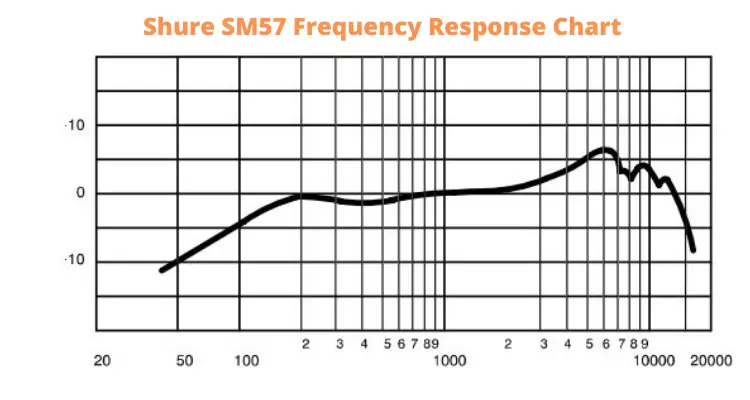
As you can see in the image, the frequency response of SM57 is boosted at the upper range near 5kHz-6kHz that making it so perfect for recording snare drums.
The other reason for its popularity in recording snares is its tight proximity effect. This tight proximity effect helps reject hi-hat’s sound, which is situated just beside the snare drum.
Features of Shure SM57
- The rugged metal makes it seriously durable, and great for on-stage uses.
- The pneumatic shock mount reduces the handling noise.
- Cardioid polar pattern and dynamic nature give better front pick-up and isolation from feedback noise.
- Ideal for percussion and drums but is also used for vocals.
- The boost at 6kHz makes it an excellent mic for snares and mid-range instruments
Pros
- Versatile and durable
- Great for vocals and instruments
- Better isolation from all backgrounds noises
- Clean, accurate, and warm sound
Cons
- Low pickup gain
- Not good for kick drum
My Verdict
SM57 is one of the most popular mics for vocals and mid-range instruments so you can buy it for multiple uses in your studio. If you don’t have a budget to purchase different mics for different applications, then you should go with this mic.
8. AKG D112 MkII
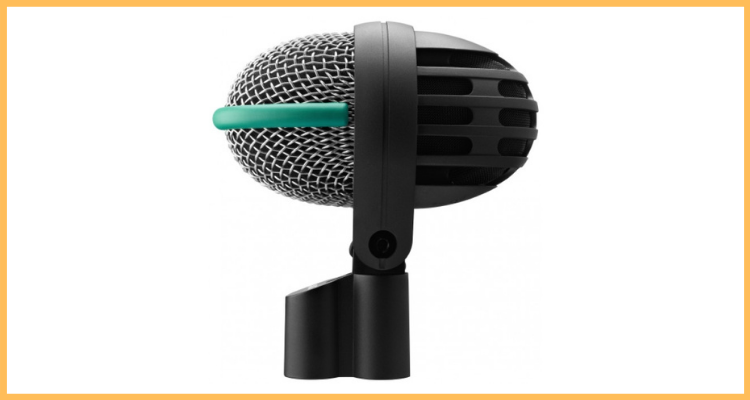
- Microphone Type: dynamic
- Polar Pattern: cardioid
- Best use: Kick drum
- Frequency Response: 20 – 17000 Hz
- Connector: 3-pin XLR connector
- Accessories included: PA microphone adaptor
AKG D112 MkII is an ideal mic for low-end instruments such as kick drums and bass guitar amps. The frequency graph, i.e., as low as 20Hz, makes it a very versatile mic for all your low-end bass applications.
But the best feature of this mic that I really like is its SPL level. It can tackle maximum SPL level up to 160dB, making it ideal for high SPL instruments such as kick drums.
Moreover, the cardioid polar pattern makes it most sensitive at the front and least at the back which means low feedback noise.
However, it’s specifically designed for kick drums; the extensive frequency response graph makes it compatible with other bass instruments such as bass guitar and bass amps where you need some boost at 3kHz.
Features of AKG D112 MkII
- AKG D112 MkII features a large-diaphragm dynamic microphone.
- It comes with a flexible integrated mic mount that avoids unwanted noise.
- Amazing performance.
- Cardioid polar pattern mic ideal for kick drum and other low-frequency applications.
- Large-diaphragm technology that provides a powerful bass response.
- Maximum SPL level upto 160dB.
- Dark gray metallic enamel finish.
- Affordable price
Pros
- Enhanced stand mount.
- Large-diaphragm delivers precise frequencies.
- Multipurpose use, Ideal for kick drums and bass guitars
- Integrated coil for hum compensation of kick drums
- Effectively cuts down any ambient noise.
Cons
- Needs proper mic placement to avoid off-axis capture
My Verdict
AKG D112 MkII is a revolutionary mic for kick drums and bass guitars. Moreover, it’s an affordable mic, ideal for home studios and stage performances.
If you are searching for a mic specifically designed for kick drums under your budget, then you can go with AKG D112 MkII.
But if you want a multipurpose mic that is equally useful for bass, mid, and high-frequency instruments, you should not go with this mic.
9. Shure SM7B
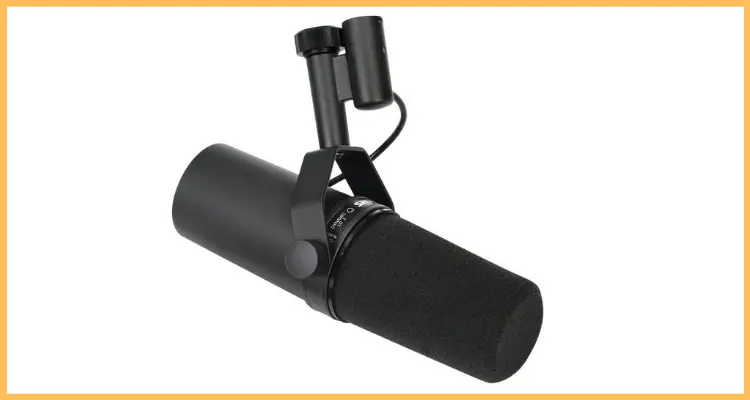
- Microphone Type: dynamic
- Polar Pattern: cardioid
- Best use: Snares, toms, vocals
- Frequency Response: 50 to 20,000 Hz
- Connector: 3-pin XLR connector
- Accessories included: Detachable Windscreen, Switch Cover Plate
Shure SM7B is specially built for vocals, but it effectively captures snares, toms, and other mid-range instruments.
It has a smooth, flat, wide-range frequency response which is great for capturing mid-range instruments.
In addition, the cardioid polar pattern provides better isolation from background feedback so that you can use this in drums.
One more thing I lie in this mic is its excellent shielding against electromagnetic hum generated by computer monitors, LED lights, and other electronic devices.
Features of Shure SM7B
- A flat, wide-range frequency response ideal for all types of mid-range instruments
- It features bass roll-off and mid-range emphasis (presence boost) controls
- Shielded against electromagnetic hum
- Internal air suspension shock mount to eliminate all kinds of mechanical noise
- For easy mounting and dismounting, a yoke mounting with a captive stand and nut is given in the box
- The cardioid polar pattern is provided for off-axis feedback rejection
- Durable, rugged construction
Pros
- Durable rugged construction
- Mid-range boost and bass roll-off
- 3 frequency response settings
- Low noise
Cons
- High price
- Needs gain boost
My Verdict
Shure SM7B is specially built for vocals; however, it’s equally useful for snares and toms. So if you are searching for a multipurpose mic that you can use with vocals also, then this is the mic you should go with.
But keep in mind, it’s not a mic specially built for snares and toms, so you won’t get the performance that a snare or tom mic gives.
10. Sennheiser MD 421
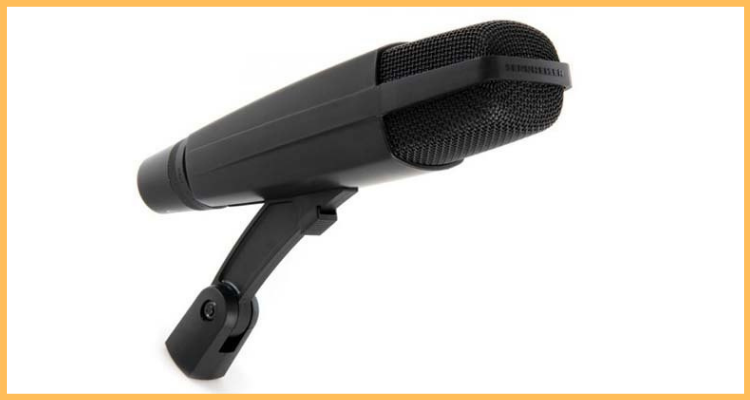
- Microphone Type: dynamic
- Polar Pattern: cardioid
- Best use: Kickdrums, toms
- Frequency Response: 30 – 17000 Hz
- Connector: 3-pin XLR connector
- Accessories included: microphone clamp
Sennheiser MD 421 is one of the best mics to capture loud instruments such as kick drums and toms. It has a maximum SPL level of up to 160 dB, which is excellent for handling kick drums.
The polar pattern (cardioid) is perfectly designed to combat feedback noise. You can use this mic for several applications such as toms, kick drums, guitar cabinets, etc.
Features of Sennheiser MD 421
- Made with composite glass housing and hardened stainless steel basket, which is rugged and durable for a long time use
- Five-position bass roll-off switch comes with a proximity effect
- Frequency response 30Hz–17kHz with mid boost
- The cardioid polar pattern is specifically designed for effective feedback rejection
- Clear sound reproduction
- It can handle exceptionally high sound pressure levels up to 160 dB
Pros
- Along with drums, equally useful for vocals
- High SPL level
- Five-position bass roll-off switch
- Less sensitive to dust and humidity
- Effective feedback rejection
Cons
- Mic clip is fragile and hard to use
- Some off-axis leakage
- High price
My Verdict
Sennheiser MD 421 is a mic for overall use in studios and stage performances. Along with drums and guitar cabinets, it’s equally useful for some vocal genres such as rock, hip-hop, etc.
In my opinion, if you have the budget to buy this mic and don’t want to use different mics for different applications, then this mic is good to go.
5 Best Drum Mic Kits
Now let’s talk about drum mic kits.
Drum mic kits are packages of 5-6 mics used for different drum parts. Drum mic kits are handy for beginners. However, when you are a beginner, you don’t know how to choose mics for different parts of the drums.
Drum mic kits are for them.
There are some benefits of drum mic kits over individual drum mics. Such as,
- You get all in one box which means you can easily handle mic kits during concerts.
- Drum mic kits are specially built for drums so that you will get the perfect sound reproduction.
- And the most important thing is you don’t have to waste your time and money searching for suitable mics for different drum parts. You get it all in one box.
Below I have introduced you to the 5 best drum mic kits to purchase for your recording studio or live purpose.
The first one is,
1. Audix DP7 Plus
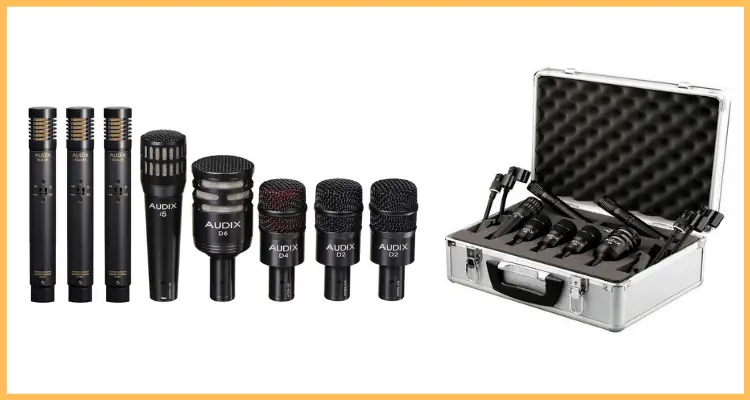
Audix DP7 is a bundle of 7 mic pieces. This mic kit is an outstanding combination of seven microphones specially designed to meet today’s professional drumming demands.
Audix DP 7 is equally valuable for both on the stage and in the studio.
In this package, you will get an Audix D6, one of the most versatile kick drum mic, two pieces of D2 dynamic drum microphones for toms, one D4 for floor tom, an i5 for snare, and two pieces of ADX51 studio condenser microphones for overhead miking.
You will also get mounting clips for all the mics.
Features
- Audix D7 is an all-in-one solution for miking drums
- Instrument-specific mics for better sound reproduction
- Rugged Audix quality
- Easy handling for stage and studio
- Mounting clips provided for easy positioning
- Road case for easy handling and storage
My Verdict
Audix D7 is built for all-in-one drum miking. It has 7 drum mics so that you can mix any drum with this kit. Of course, you have to pay more for a 7 mics kit. If you need a mic kit for all types of drums, this mc kit is for you.
2. Shure PGADRUMKIT5
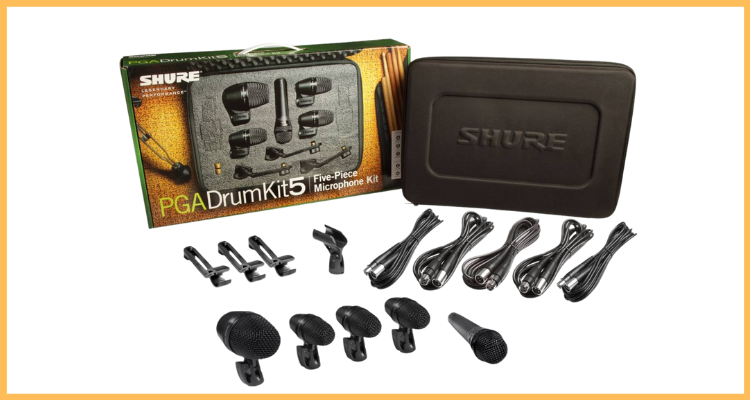
Shure PGADRUMKIT5 is a bundle of 5 drum mics. You will get professional quality microphones specially designed to provide excellent sound reproduction for kick drum, snare, and tom in this package.
In this package, you will get one PGA52 kick drum mic, three PGA56 drum mics, a PGA57 instrument mic, three drum mounts, five XLR-XLR cables, and a carrying case.
Features
- 5-piece mics; Shure PGA52, 3 x Shure PGA56s, Shure PGA57
- Shure PGA52 is provided for kick drum
- Shure PGA56s is provided for toms
- Shure PGA57 is provided for harmonically rich, high SPL sound sources
- Mic clip mounts supplied for all the mics
- XLR cables to connect the microphones
- Case included
My Verdict
Shure PGADRUMKIT5 is a five drum mics package that can be used for medium-sized drums. If you are not planning to record big-size drums, then it’s best for you. It is equally helpful for recording studios as well as for stage performances.
3. Shure PGADRUMKIT7
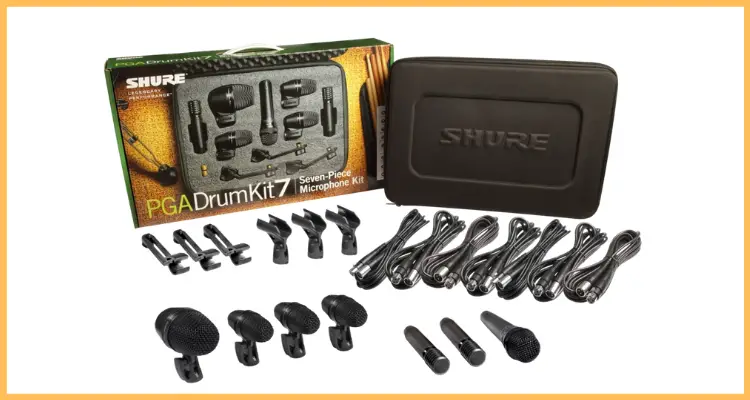
Shure PGADRUMKIT7 is another drum mic kit for big-size drums. It is a complete package of professional quality microphones specially designed to provide excellent quality sound for complete drum kits.
In this package, you will get one PGA52 kick drum mic, three PGA56 drum mics, one PGA57 instrument mic, two PGA81 instrument mics, three drum mounts, seven XLR cables, and the carrying case.
Features
- 7-piece mics included in this package, i.e., Shure PGA52, 3 x Shure PGA56s, Shure PGA57, 2 x PGA81
- Shure PGA52 is built for kick drum.
- Shure PGA56s is built for toms.
- Shure PGA57 made for harmonically rich, high SPL sound sources.
- Shure PGA81s made for drum overheads.
- You will also get mounting clips for all mics.
- XLR cables to connect the microphones
- Carry case included
My Verdict
Shure PGADRUMKIT7 is a package created for a complete drum kit. You will get 7 mics in this package which can be used to record any drums.
Just like Audix D7, you can use it for big-size drums. If you are planning for the same, then this mic kit is for you.
4. Sennheiser E600 Drum Mic Kit
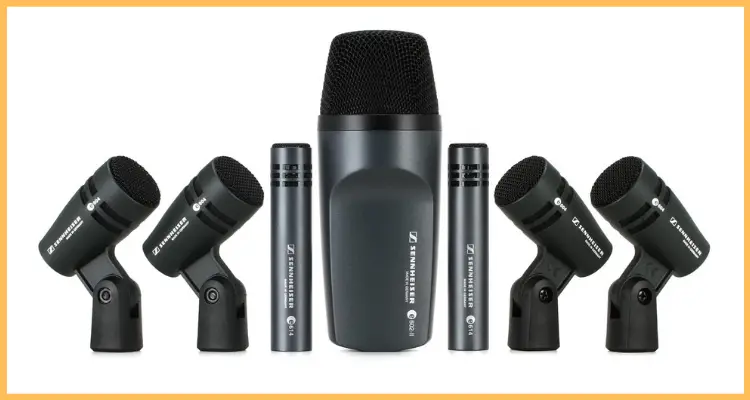
Sennheiser E600 is another drum mic kit for complete drums.
In this package, you will get one 602-II cardioid instrument microphone for bass drums, four e 604 cardioid microphones for snare and tom-tom, and two e 614 super-cardioid polarized condenser mics for cymbal and overhead applications.
Features
- 7-pieces mics included in this package, i.e., one 602-II cardioid instrument microphone, four e 604 cardioid microphones, and two e 614 super-cardioid polarized condenser mics
- Sennheiser 602-II is built for kick drum.
- Sennheiser e 604 is made for toms and snare.
- Sennheiser e 61 is made for cymbals and overheads.
- You will also get mounting clips for all mics.
- Carry case included
My Verdict
Sennheiser E600 series mic kit is a 7-mic set so helpful for all types of drums. However, you can’t aspect the sound quality like Shure and Audix.
It’s amid a budget mic kit for drums, so if you don’t have more budget, you can go with this mic kit.
5. Avantone Pro CDMK-8 Drum Mic Kit
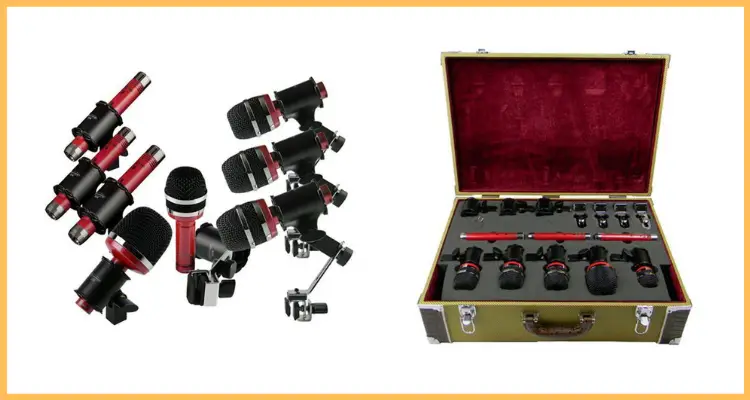
Of all the mic kits I have discussed earlier, this is the biggest mic kit with eight mics in the box. Avantone Pro CDMK-8 Drum Mic Kit is a bundle of 8 mics so that you can use for almost every type of drum machine.
In this package, you will get one Mondo kick drum mic, one ADM snare drum mic, one ATOM tom mic, two CK-1 cardioid condenser mics for overheads, and one CK-1 hyper-cardioid condenser mic for hi-hat, along with the mic mount clips, shock mounts, and the carry case.
Features
- It is a complete 20-Piece Drum Mic Kit
- 8 Microphones are included in this mic kit
- one ADM snare drum mic, one ATOM tom mics, two CK-1 cardioid condenser mics for overheads, and one CK-1 hyper-cardioid condenser mic for hi-hat
- SSM Metal Shockmount provided in the package
- Heavy-Duty carry case
My Verdict
This is the biggest drum mic kit of all I have discussed earlier in this section. It can record almost every type of drum kit. So, if you want something more under a limited budget, you should go with this mic kit.
5 Steps to Drum Mics Placement Guide
This chapter is all about drum mic placement. In this chapter, I will give you some quick tips about mic placement for drums.
I have divided this chapter into 5 parts,
- Room size
- Mic direction
- Distance of mic
- XY method for overhead miking
- Bass drum mic placement
After reading these quick tips, you will get a brief idea of how to place drum mics for recording.
First off,
1. Room Size
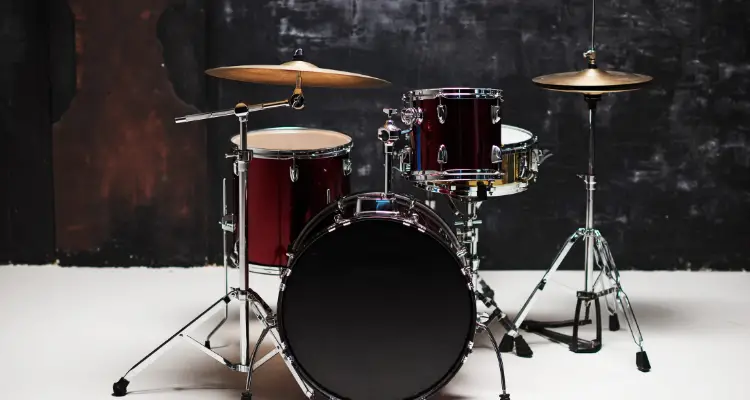
Room size always matters in audio recording. Although, today, small-size studios are in trend, and most beginners start with small recording studios. But, if you want to record drums in your recording studio, you should have a big size room.
If you set up a drum machine in a small room, you will get reflections that are not good for recording. You need enough space to make the sound play.
There is another significant benefit of big size rooms. As you know, that drum machine is made of different parts such as toms, snare, kick drums, cymbals, and hi-hats.
So drums need much more space to set up than other instruments. That’s where a big size room is required for drum machines.
Here you may wonder which size is ideal for a drum machine.
The answer is minimum of 20X15 feet of room is required. However, you can go with a smaller size, but if you want realistic drum sound reproduction, I recommend a 20X15 feet room.
Smaller than 20’X15′, you will get reflections that would ruin your project.
2. Direction of Mic
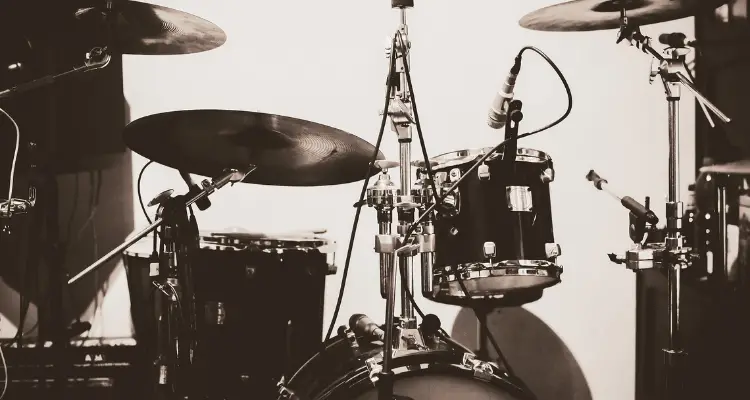
As most drum mics are unidirectional cardioid microphones, you need to place the front face of the mic on the drums.
Otherwise, you will not get the perfect sound.
Unidirectional microphones are used to minimize the background feedback noise, so if you don’t put the mic in the right direction, you will get that feedback on your mic, which is not suitable for recording.
So, always place the face of the mic on the instrument.
3. Distance of Mic from the Instrument
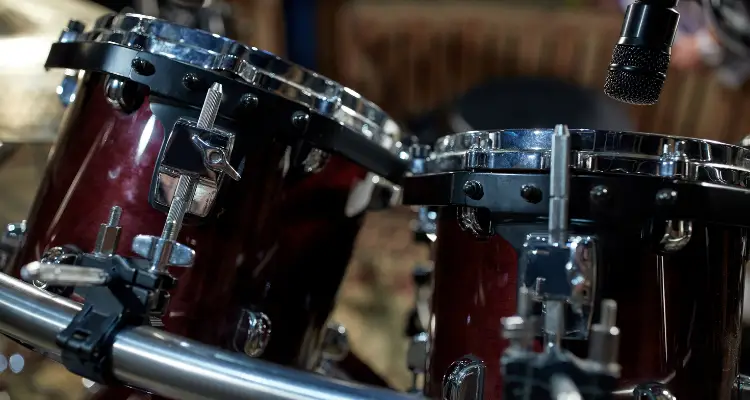
As drums are high SPL instruments, the distance of the mic should be anywhere between 10-15 Inches from the instrument. If you put the mic too close to the instrument, it can cause severe damage to the mic’s diaphragm.
On the other hand, if you put the mic too far from the instrument, then you won’t get sufficient sound to record.
4. XY Method Overhead Miking
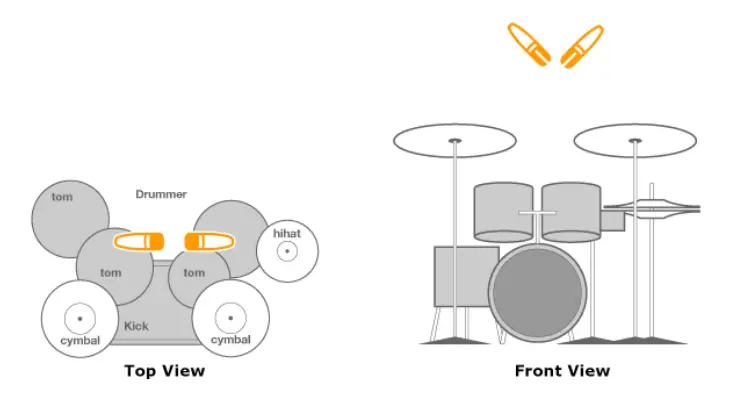
Overhead mics are used to record the overall sound of the drums.
So, you should use the X-Y axis method to get the perfect sound reproduction by the mics.
For more information on the X-Y miking method, you can refer to this article.
5. Kick Drum Mic Placement
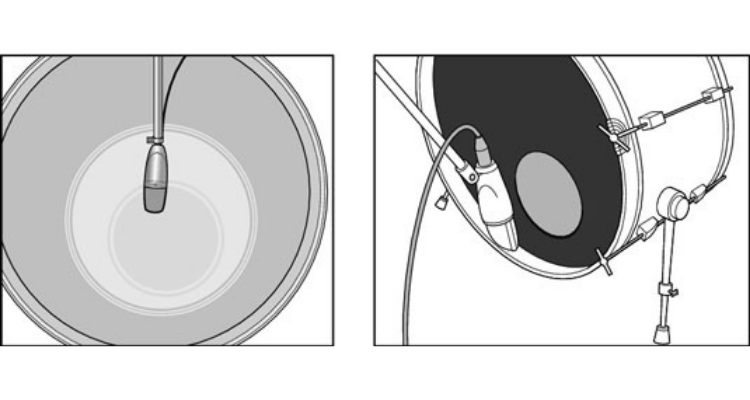
Miking snares, toms, etc., is not as tough as a kick drum. In kick, drums mic is placed inside the instrument. You need kick drum mounts to put the mic inside the kick drum.
Almost all the drum mic kits have kick drum mounts to put the mic inside. But if you go with an individual mic, then you have to buy this mount separately.
Note: If you put the kick drum mic outside the drum then you will not get the perfect sound reproduction. So place it inside.
General FAQ About Drum Mics
Condenser or Dynamic, Which one to choose for drum recordings?
If you want to record drums, you should choose the condenser and dynamic mics. Condenser mics should be used as overhead miking, and dynamic mics are for kicks, snares, toms, and percussions.
When you are using drum mics in concerts, you should go with dynamic mics; otherwise, you will get feedback from the background.
Why should we use different mics for kick, snare, cymbals, hi-hats, and toms?
Drums are a set of different instruments. The frequency graphs of all these frequencies are different from each other. Hence y
Do we need Mic Preamps for Drum Mics?
Yes, of course. In fact, in today’s audio interfaces, mic preamps are already given to amplify the weak mic signals.
Should we use different tracks for kick, snare, cymbals, hi-hats, and toms, or route all the mics to a single track?
It depends on you. If you manage to pre-mix all the instruments through the mixer, you can use a .single track. But if you want to mix drums after recording, then you should use different mics.
Can we use studio drum mics in live concerts?
Yes, but don’t use condenser mics. They are very sensitive and capture feedback.
Conclusion: Drum Mics Beginners Guide
Recording drums in home studios has not been an easy task. But thanks to modern unidirectional cardioid drum mics, now you can easily record drums inside your home studio.
Yes, it needs extra space, but you can now record drums like professional studios.
In this guide, you have read all about drum mics, from the types to the placement. You have also got some recommendations from me.
Now it’s time to purchase drum mics and start recording drums in your studio.
Don’t forget to comment below about your thoughts regarding this guide. Bookmark this page and get back to here when you record drums in your studio.
We will be waiting for your comments below.
Do share this guide with others so that others could also get benefit from it.
You may also like,
- How to EQ Drums in Audio Mixing [5 HIDDEN Strategies ]
- 19 Best Drum VST Plugins (Free & Paid) 2023
- 11 Free Drum Kit Resources For Indie Composers [Updated 2023]
- 5 Ways to Micing Toms [Correctly]

